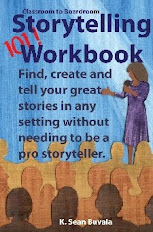Being truthful leads to reconciliation. Truth is expressed in the story of change.
Storytelling can be used for many different applications. One of the most difficult, but needed, application of storytelling is to express reconciliation, repentance and recompense.
Let’s look at real-life and very public example. As of this writing, professional football player Michael Vick is in the news as he tries to make a comeback after spending two years in jail, "doing his time" for the abuse and torture of dogs while funding illegal dog fighting. He’s on his own personal quest to be restored to his previous national career while trying to express that he’s learned his lesson, repaid his debt to society and is a new man.
Michael Vick needs to learn the art of storytelling. He needs to learn to tell the Truths he has learned. He needs storytelling to apologize.
Understand that I am appalled at his abuse of animals. However, after working many years as a professional listener in nonprofit human services, I have seen people who have committed awful crimes become contributing, forgiven role models who were/are able to positively impact the world around them. I have to assume that Mr. Vick will be in that category. Time will tell.
So, how does the Michael Vick(s) of the world seek this forgiveness? Well, along with contributions of time and treasure to causes that externally demonstrate their internal conversions, they need to craft their true story of their journey.
Here are six steps to creating the story for redemption.
1. Always tell the truth.
No mastery of storytelling techniques or communication skills will help if you aren’t ready to tell the truth about the past, present and future. When you need forgiveness and a second chance, you need to speak the truth. If not, you simply won’t have an audience when you are trying to get forgiveness the next time around.
2. Start the story with the vision of the future.
In essence, you will use your commitments to bookend your story with your vision to the new you of the future. Why? It is hard for an audience to truly listen to people they hate. By using this “bookend” technique, you allow your audience to immediately know you are ready to put your actions and not just your words into motion. For example, you might say "I know I have caused harm and pain, and I have already begun to support XYZ Organization with not only my money but 10 hours a week of volunteer time for the next few years.”
3. Acknowledge your "sin" against the world.
Be prepared to use the word "I" when speaking, not some generic "you." "I did . . . " is the correct phrase, not "sometimes you find yourself doing . . . " The use of "I" acknowledges and owns your failings. "You" means you are still not convinced of your failure.
For those of you who follow my storytelling training, you know I teach you how to break your stories into Episodic Telling. In your storytelling, some folks need to know more about your failure than others. In Michael Vick’s case, when he talks to others involved in dog fighting, his story will be more graphic. When talking to wayward youth, he might omit some details. An audience of PETA or animal-rights activists will require even different episodes.
4. Tell us about how you have paid your debt.
Let your audience know how the paying of that debt affected you both physically and emotionally. It’s time to dump the anecdotes and really talk about your life, your feelings, your fall. I’ve heard Mr. Vick say he was a jail janitor who made pennies per hour. That is only an anecdote. I don’t yet know how he felt; that will come from his storytelling. Tell me the story of working for pennies when you once had millions.
Caution! I am not talking about chest beating and crying on stage. Perhaps images of weeping evangelists come to mind? Although I want to know how you feel, I do not want you to use your story to dump emotion on me. Save that for your therapist . . . or court.
5. Express the actions you are taking now, in the present and future, that demonstrate how you have changed.
What are you doing now to create change in yourself and society? Here you are repeating the opening of your vision for your future. However, this time, do not just tell us about your thoughts, show us your feelings again. What have you learned? How has your "heart" changed? How is your life impacted and challenged because of your new actions?
Storytelling is not always used for fantasy time. Storytelling has been used always to teach and instruct. In some cases, when the desire to change is genuine, the power of storytelling can reconcile people and communities.
***
Sean Buvala is the executive director of Storyteller.net and an executive speaking coach training the use of storytelling to effect organizational change.
The official blog for K. Sean Buvala, storyteller and storytelling coach.
Subscribe to:
Post Comments (Atom)





Hello Sean
ReplyDeleteThis is an excellent post! You have articulated an important use of stories for apologies and healing. I am going to share this on my blog at http://self-expression.com/speaking-freely.
Thanks for this new use of stories!
Sandra Zimmer
www.self-expression.com